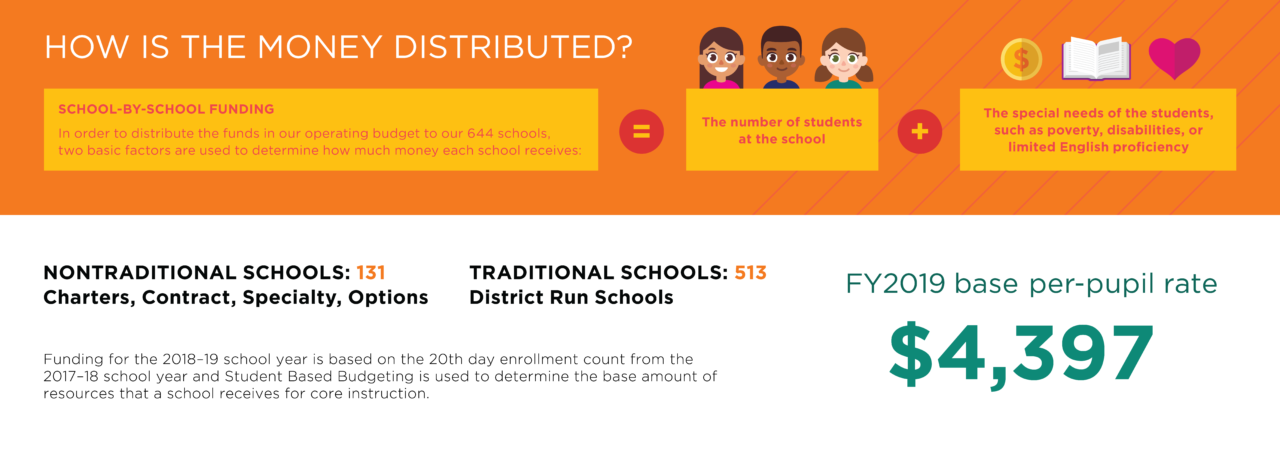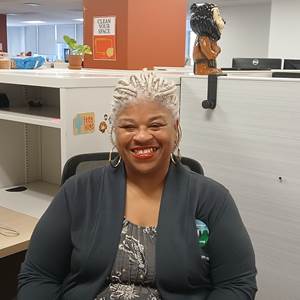Here’s the Short Version of How Our Budget Works
25 September 2018
As a district, it’s crucial that we are transparent about how we use taxpayer dollars to provide a high-quality education for students. In addition to the detailed budget book we post every year at cps.edu, we have created an additional resource for community members this year, The Resident’s Guide to the Budget.

As a district, it’s crucial that we are transparent about how we use taxpayer dollars to provide a high-quality education for students. In addition to the detailed budget book we post every year at cps.edu, we have created an additional resource for community members this year, The Resident’s Guide to the Budget.
Our Resident’s Guide provides our parents and families with a streamlined breakdown of this year’s operating budget, capital budget, and debt obligations.
Here’s what that looks like:
Operating Budget ($5.98 Billion): This budget represents the amount of funds that are allocated to operate the day-to-day activities of our school each year. We use it to track income and spending, to help manage priorities, to plan for the future and to measure financial performance.
Capital Budget ($989 Million): This budget represents the amount of funds allocated for long-term investments in our schools. This includes the cost of things like building construction and renovations. We raise the majority of this money through the issuance of bonds, which are similar to loans, and require annual payments on the bond principal and interest.
Debt Budget ($607 Million): This budget is used to pay our annual bond payments and other debt payments.
Money for our Schools

95 cents of every dollar we spend goes to providing direct support to schools like paying classroom teachers, providing meals, and ensuring schools are safe and clean.
Who Provides Our Funding?
Our funding comes from a variety of sources. Tax income from local, state and federal sources account for nearly all of our budgeted revenue. Our largest source of income, 55 percent, is generated by local sources. For more of a breakdown, check out this pdf.
What Do We Spend Money On?
Our Operating Budget is $5.98 billion and it is used to pay both employees ($3.95 billion) and non-employee ($2.03 billion) costs.
When we look at employee costs, 66 percent of the CPS budget is used to pay for the salaries and benefits of our 37,000 employees. This includes our central office staff who provide administrative and programmatic support to the schools and network office staff that support schools.
Another part of this budget is used to support our school-based staff like our teachers, principals, teacher aides, security officers, school clerks, cooks, and custodians. We also have city-wide support staff, which includes coaches, clinicians, nurses, social workers, and speech pathologists.
We use the remaining 34 percent of the budget on expenses such as paying for school lunches and utilities. A few examples of other expenses included in this budget are building supplies, instructional supplies, and equipment like furniture and computers. The full list can be found in the full Resident’s Guide.
The Capital Budget for 2019 is $989 million. So how are we using the funds for the Capital Budget?
Here are the five ways.
Educational Programs and Site Improvements: $385 million
These funds cover building renovations and the designing and construction of new playgrounds, turf fields, high school science labs, and more. Check out the Resident’s Guide for the full breakdown.
Critical Facility Needs: $336 Million
We use this to address the district’s priority renovation projects and most urgent facility needs.
Overcrowding Relief: $138 Million
As a district we understand that students learn best in a safe and comfortable learning environment. Currently, some of our schools are overcrowded, which is why the 2019 Capital Budget includes $138 million to alleviate overcrowding and provide additional classroom and programming space at Dirksen, Palmer, Rogers and Waters elementary schools.
Modern Computing Resources: $50 million
We’re improving the technology in our schools, and modernizing equipment across the district. To do that, we’re beginning a four-year, $125 million investment – with $50 million for the first year.
IT and Security Upgrades: $38 Million
This means that we’ll be upgrading the district’s IT systems, security equipment, and temperature control replacement, as well as making sure our schools have air conditioning.
How is the Money Distributed?

We look at two primary factors to determine how we distribute funds from our Operating Budget: the number of students at each school and the special needs of the students, such as poverty, disabilities, or limited English proficiency.
The full description and breakout can be found on page 4 of the Resident’s Guide.
Our Vision
CPS continues to invest in areas that drive student achievement and reflect the values and priorities outlined in our 3-Year Vision, which focuses on three things: academic progress, financial stability and a district-wide commitment to integrity.
To build on our academic progress we’re investing $3.1 billion in our school budgets for 2019. That’s an increase of more than $60 million compared to the prior school year.
Other investments worth noting include our $75 million investment in high school science labs; expanded full-day pre-K; and adding new staff and creating two new departments (Office of Student Protections and Title IX, and the Office of Equity) to improve student protections and equity across the school district.
And that’s the full overview of our Resident’s Guide. We hope that this was helpful and please make sure to share the guide with your friends and family.
Related Stories
31 October 2025
Take Five with Maureen Moroney, Physical Therapist with the CPS Office for Students with Disabilities
Dr. Moroney's main priority is to get her students moving throughout their school as safely and independently as possible.
26 September 2025
Take Five with Caroline Depcik, Deaf and Hard-of-Hearing Itinerant Teacher with the CPS Office for Students with Disabilities
Ms. Depcik strives to be a role model for students who are deaf and hard of hearing.
12 September 2025
Take Five with Lillian Wilkins: Hotline Support Representative in the Office of Access and Enrollment
Lillian wants the enrollment process to be as seamless as possible for families.
16 May 2025
Getting Ready for My Future as a CPS Teacher: Take Five with Madison Dancer
Madison recently graduated with her bachelor’s degree in elementary education, but her journey with Teach Chicago Tomorrow is not over!




